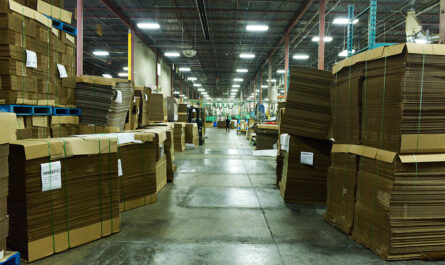Industrial Packaging: Ensuring Product Security and Safety During Transport
A wide variety of materials are used in Industrial Packaging to suit different product and transportation needs. Some common materials include cardboard, paper, plastics, wood, and metals.
Cardboard and paper are popular and affordable packaging materials. Corrugated cardboard in particular is very durable and provides excellent protection for goods during shipping. It is moisture-resistant and can withstand some external stresses. However, cardboard is not suitable for heavy or fragile items that require more robust containment.
Plastics such as polyethylene, polypropylene, and polystyrene are extensively used for Industrial Packaging. Plastic provides an effective moisture and vapor barrier. Rigid plastics like polyethylene terephthalate (PET) and high-density polyethylene (HDPE) offer strong protection and can be thermoformed into custom packaging solutions. Flexible plastics like polyethylene and polyvinyl chloride (PVC) films are useful for wrapping and sealing products. However, plastics are not as reusable or recyclable as other materials.
Wood remains a practical packaging material thanks to its strength, rigidity, and sustainability credentials. Wooden crates and pallets effectively cushion and brace packaged items. However, wood requires more material than other options and can deteriorate if exposed to moisture or pests over long periods.
Metals bring durability and security to Packaging. Steel and aluminum drums, kegs, cans, and boxes protect their contents from damage and tampering. Their thickness and structure make them highly impact-resistant. However, metal packaging tends to be heavier and more expensive to produce than alternatives.
Design Considerations for Industrial Packaging
Several factors must be considered in the design and configuration of Packaging:
Product Protection – Packaging must minimize movement and forces on the product during transport. Bubble wrap, foam, inserts, and bracing secure items safely within boxes and containers.
Transportation Requirements – Packages are designed to stack, nest, and be lifted by forklifts or manually depending on how they will be shipped. Pallet sizes, weight limits, dimension restrictions also influence design.
Durability – Packaging endures wear from transportation, loading/unloading, and warehousing. It should withstand impacts, crush pressures, moisture, temperature fluctuations without compromising the product.
Branding and Labeling – Space is allocated for identifying labels, barcodes, handling instructions, trademarks, and marketing information to aid logistics and end users.
Regulations – Packaging meets legal requirements for safety, hazardous materials transportation, import/export standards, and restricted materials.
Cost Considerations – Materials, production processes, and package design aim to maximize value against protection needs and costs of transportation, storage, and disposal.
Sustainability – Recyclability, reuse potential, recycled content, minimized waste generation factor into environmentally responsible options.
Usage of Barcodes, RFID in Industrial Packaging
Advanced identification technologies streamline Packaging and the logistics processing. Barcodes revolutionized inventory management by automating tracking of individual packages and their contents. Linear or 2D barcodes printed on labels provide a machine-readable system of unique identification numbers. Handheld barcode scanners instantly relay critical package data throughout the shipment workflow.
Radio-frequency identification (RFID) presents an even more powerful automated identification option. RFID tags containing microchips and antennas transmit signals for radio receivers to detect and identify packages without line of sight. As RFID tags become smaller and more affordable to integrate, they offer advantages like:
– Ability to track multiple packages simultaneously compared to linear scanning of barcodes
– “Smart” capabilities to monitor environmental conditions or product integrity
– “Read-only” or rewritable memory capabilities depending on requirements
– Long read ranges from a few inches to hundreds of feet depending on tag and reader tech
Combined with data analytics of tagging and tracking data, advanced identification opens possibilities for real-time product visibility, optimized routing, automated sorting/assembly, predictive maintenance, and overall improved supply chain responsiveness.
Quality Assurance in Industrial Packaging Operations
Robust quality control measures minimize errors and protect brand reputation in Packaging operations. Standard processes include:
Package Testing – Random sample packs undergo vibration, impact, compression, and environment tests to verify ability to withstand typical distribution cycles without failure.
Inspection Stations – Packages are examined at different production stages to catch defects in materials, assembly, sealing, labeling etc. before shipment.
Statistical Process Control – Production data monitors capability and stability of packaging line processes to flag when corrective action may be needed.
Audits – Compliance with technical specifications, safety/ethical standards, and customer requirements ensures through documentation reviews and facility assessments.
Corrective and Preventive Action – Issues are promptly investigated and fixed. Root cause analysis prevents reoccurrence by addressing processing or design-related problems.
Certification – Packaging companies obtain certifications like ISO 9001 for their quality management systems to meet customer and regulatory standards.
Training and Competency – Occupational safety, good manufacturing practices etc. enable workers to package products consistently and competently.
Overall quality assurance defends the integrity, safety and on-spec performance of packaged industrial goods through rigorous monitoring, continuous improvement, and third-party validation where needed.
Future of Industrial Packaging
Numerous technology-driven trends envision even smarter, greener, and more automated packaging approaches in future industrial applications:
– Internet of Things (IoT) enablement via integrated sensors to monitor shipments in real-time
– Additive manufacturing of custom, lightweight packaging using 3D printing
– Artificial intelligence (AI) and machine learning to optimize packaging designs
– Augmented/virtual reality applications in prototyping, training and remote collaboration
– Alternative materials like bioplastics from renewable resources
– Integrated serialization and traceability via distributed ledgers (blockchain)
– Increased automation through robotics, autonomous vehicles, automated picking/packing
– Packaging-as-a-service business models leveraging the latest technologies
By continually innovating packaging methods and taking advantage of emerging technologies, industry stands to realize substantial benefits in areas such as sustainability, productivity, safety/compliance and customer experience over the long run. Proactive vision keeps Industrial Packaging relevant and indispensable in dynamic global supply chains.
*Note:
1.Source: Coherent Market Insights, Public sources, Desk research
2.We have leveraged AI tools to mine information and compile it




